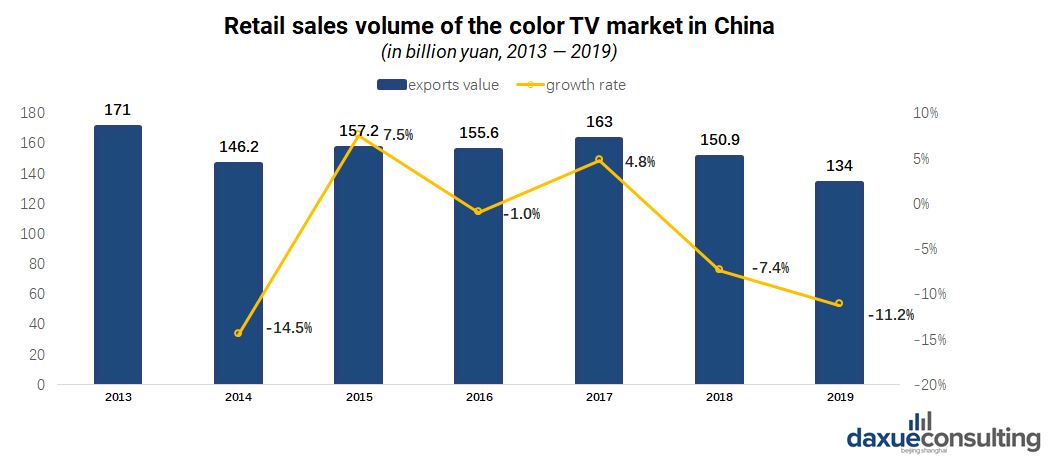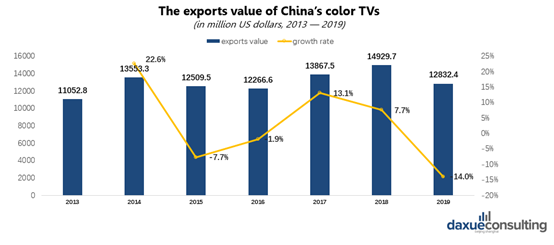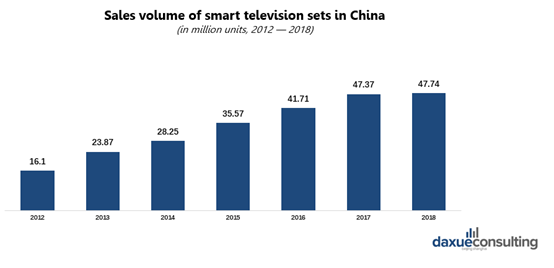Overview of the television market in China
The television market in China entered a long ‘winter season’ around 4-5 years ago. A series of problems emerged, including the decline in TV sales, the endless price war, and the difficulty in product innovation.
In 2018, the retail volume of China’s color TV market was 47.74 million units, with a slight increase of 0.5% year-on-year, but retail sales value decreased by 8.6%. Come 2019, 47.72 million color TVs were sold, and the sales volume dropped 2.0% year-on-year. In the same year, the retail sales were 134 billion yuan, declining 11.2% year-on-year. The average price of TV’s in China is 2,809 yuan, which is the lowest number during the past decade.

[Data Source: China Household Electrical Appliances Association, “Retail sales volume of China’s color TV market”]
Time spent on mobile surpassing TV
According to eMarketer, 2018 marks the first year where Chinese people spend more time with their digital devices than they do watching TV. As of 2018, the average Chinese adult spends more time on mobile devices (smartphones, tablets, etc.), about 2 hours, 39 minutes, than they do with TV. The average Chines adult spends 2 hours, 32 minutes watching TV this year, down 2% over 2017, which equates to a 7-minute difference. It is predicted that by 2020, adults in China will spend almost a third of their daily digital time watching videos.
“eMarketer’s forecasts are showing that in China, time spent watching TV will experience an accelerated decline, with TV viewership falling further in lower-tier cities,” said Shelleen Shum, forecasting director at eMarketer. Since the television era began, TV has been the primary source of entertainment, and the Chinese television market grew rapidly from the mid-1990s to 2014. However, the Chinese audience is losing their interest in watching TV yet with rising digital media consumption, which impedes the development of the television market in China.
China ranks first in color TV production
China’s color TV industry started in the mid-1970s and has experienced three periods: the growth period from the mid-1970s to the early 1990s, the maturity period from the mid-late 1990s to the end of the last century, and the second development period from the beginning of this century to now. After more than 40 years of development, China’s color TV industry has grown to become the world’s largest. In 2014, the production of color TVs in China was 155.42 million units, and in 2018 it exceeded 200 million units.
China exports a higher value than imports in the TV market
For the exports of televisions, China is a significant color TV exporter. According to statistics, China exported 74.05 million color TV sets in 2014, with an export value of USD 13.553 billion. In 2018, the export volume and value of color TV set both increased, and the export volume rose to 96.88 million units, with the export value approaching 15 billion US dollars. From January to May 2019, 37.56 million color TV sets were exported, an increase of 11.6% year-on-year. The export value was US $5.296 billion, a decrease of 1.1% year-on-year. Negatively affected by the US-China trade war, China’s color TV exports reached 94.74 million units in 2019, with a year-on-year decrease of 2.2%. The average export price is $ 0.1355 per unit.

[Data Source: China Household Electrical Appliances Association, “The exports value of China’s color TVs”]
China‘s color TV import value is far behind exports. China’s color TV imports value reached $17.055 million in 2018, with a decrease of 30%. Imports reached US 15.39 million in 2019, decreasing 9.8%. The average import price was the US $1.26 per unit, over nine times the average export price.
The smart TV market in China grows gradually

[Data Source: China Industry Information Website, “Sales volume of smart television sets in China”]
Despite the slumping television market, the smart TV market in China has stable growth. Unlike traditional cable TVs, smart TVs offer internet connectivity and support for a range of apps, much like smartphones and smart home devices. Smart TV has become a new type of electronic equipment and has entered thousands of Chinese households through Internet extension.
In 2018, China’s smart TV sales exceeded 50 million units, increasing to 47.74 million units from 16.1 million units in 2012. Also, intelligent TV ownership has grown rapidly in recent years, rising from 120 million units in 2016 to 188 million units in 2018.
Learn from TCL’s strategy

[Source: TCL official website, “TCL’s smart televisions”]
About TCL Electronics Holdings Limited
Headquartered in Shenzhen, China, TCL Electronics Holdings Limited is one of the leading companies in the global TV industry engaging in the research and development, manufacturing and sales of consumer electronics products.
Despite the downward trend of the domestic TV market, TCL maintains growth under the COVID-19 pandemic. Around the Labor Festival, the online and offline retail sales of TCL TVs increased by 2.24% and 7.3%, respectively, and TCL’s market shares were 13.8% and 19.43%, respectively. The success of TCL attributes to two main strategies, which can be drawn on by other brands. According to Sigmaintell, the brand ranked second in the global TV market in terms of its market share in the first three quarters of 2019.
Technological upgrades to create growth
At the 2020 Spring Product Launch—”TCL Making Life Intelligent”, TCL launched several kinds of TVs marketed as “Large-screen Sound and Picture Experts that Understand You”. The new-introduced TV products are categorized in 3 series, including “C8 Zhizhen QLED TV”, “P9 Hollywood Theater TV” and “V8 full scene AI TV” equipped with further enhanced sound and picture technologies and new Artificial Intelligence (AI) function.
“The biggest change in the COVID-19 epidemic is the change in our home lifestyles: People pay more attention to smart technology products and are more accustomed to the protection and convenience brought from these products to everyone’s life.” Wang Cheng, CEO of TCL Electronics Holdings Limited, said.
Considering the rapid development of the smart TV market in China, TCL focuses on “smart technologies + Internet” and “products + services”, introducing more high-tech smart TV sets. With technological advances in smart televisions, the company is striving to build a comprehensive ecosystem for smart TVs, which leads to a new and smart home lifestyle in China.
Live video streaming to boost sales
On April 13th, the world’s first TCLXESS rotating intelligent screen with “new ideas in all directions” was officially launched on the Jingdong platform. TCL Industrial Holdings CEO Wang Cheng, TCL global brand spokesperson Tang Jingmei and eight KOLswere live broadcasting to sell TCL’s products. According to statistics, 830,000 people were watching live online, and the number of likes is as high as 1.45 million. In just 1 minute, the sales volume of the entire network has broken 3,000 units, and within only 1 hour, the total sales online have broken 10,000 units.
During the Labor Festival period, TCL brand sales in the Gome platform achieved more than 60% year-on-year growth, with 55-inch and 65-inch smart 4K TV sales exceeding 30,000 units. Only on May 1st, within 3 hours of the live broadcast of the theme “To Fight for a Better Life” co-launched by CCTV News and Gome, the sales of TCL C66 series increased over 55% year-on-year.
The promotion strategy behind TCL’s live broadcasting is worth learning. Driving the traffic from public media platforms and online shopping platforms, TCL can build its own private traffic pools to reach customers easily and manage retention effectively. In this way, the brand successfully refines online sales in the Chinese television market.
Coronavirus impacts on the television market in China
Under the coronavirus outbreak, Chines people keep staying at home and tend to spend more time watching TV. According to a survey, the audience’s size and time spent watching TV have increased significantly during the epidemic, compared with the past six months. As shown in the survey, 54.9% of people watch TV every day, increasing by 16.6% over the past six years, and the average viewing time increased by 66.7%.
However, the COVID-19 epidemic has considerable adverse effects on consumption in the Chinese television market. According to “the Color TV Market Scale during Labor Day Holiday” published by Zhongyikang, the retail sales volume of the color TV market fell 6.3% year-on-year, while the retail sales dropped 16.4% year-on-year.
Overall, for the television market in China, coronavirus makes the bad situation even worse, and many brands are facing great challenges. However, it is worth noting that TCL outperforms during a particular period, and brands can learn from the product and promotion strategy of TCL.
Listen to 100 China entrepreneur stories on China Paradigms, the China business podcast
Listen to China Paradigm on Apple Podcast






